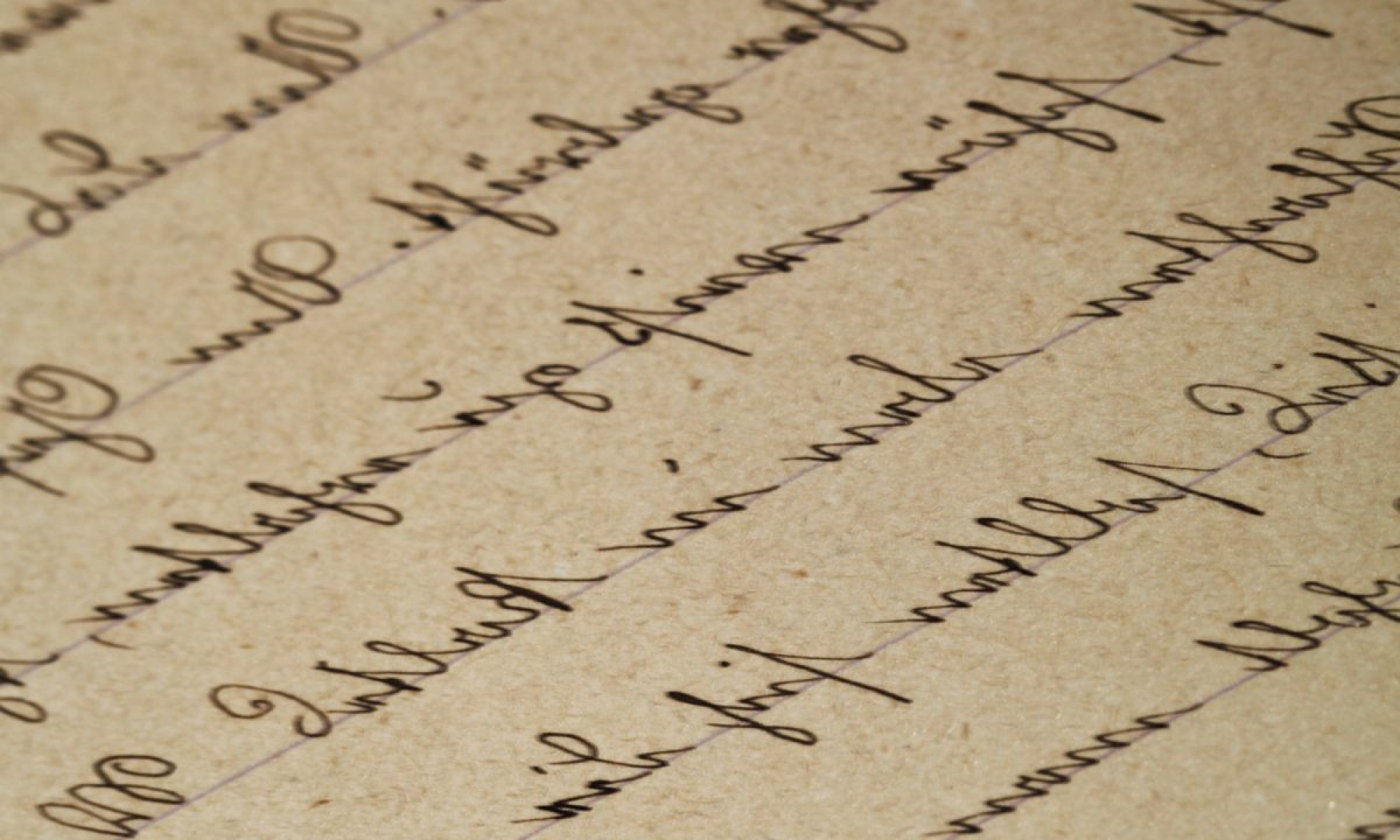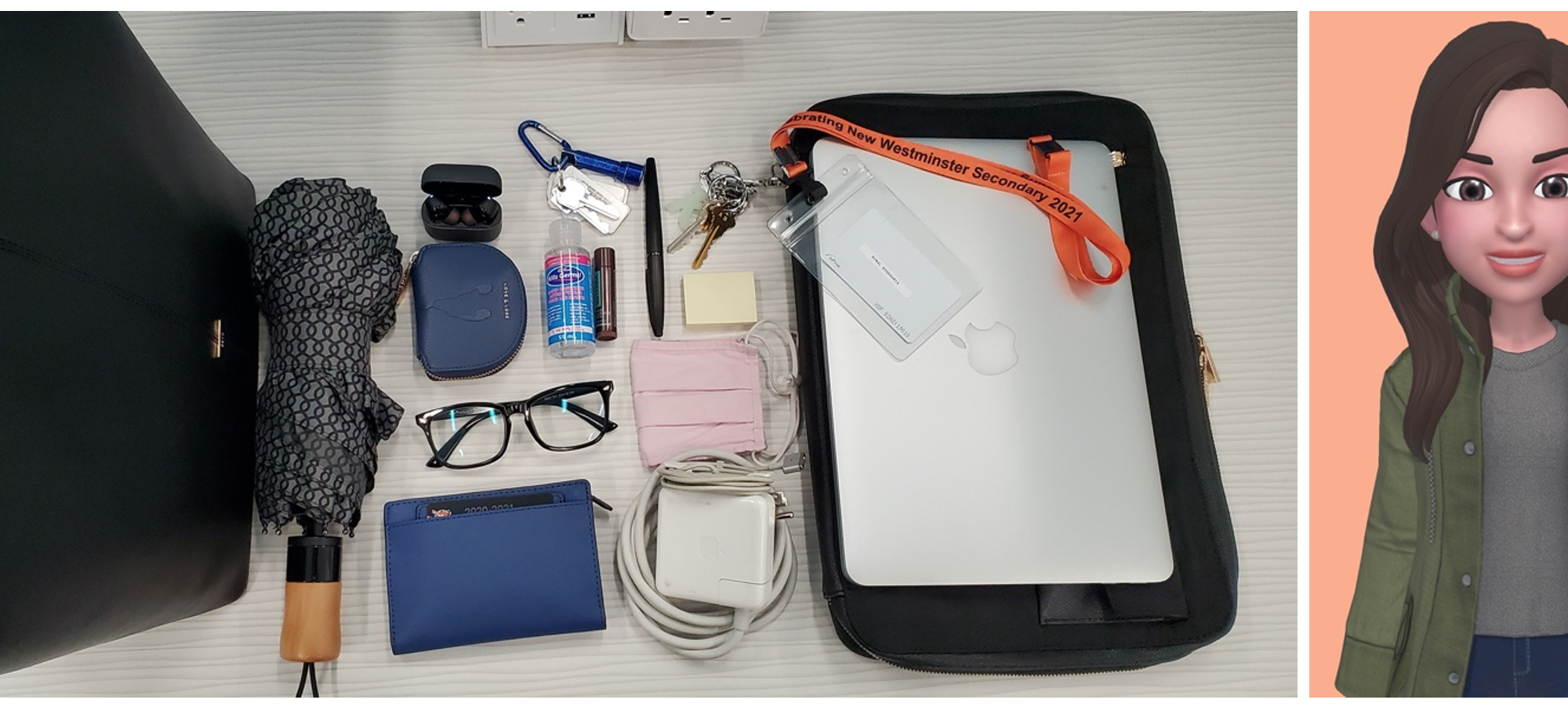This was such an interesting experience. It definitely made me reflect on my personal language journey and what each language I know says about me, my culture, my background, etc. “How language shapes thought” is a phrase worth exploring more, and I know for sure that I will be paying more attention to how I think depending on which language I am thinking in…
Task 1: What’s In Your Bag?
I carry what is referred to as a bucket bag (1), to and from work every day. It is easy to dump “stuff” into it as well as find it when I need it. The stuff, pictured above, are all items of necessity: an umbrella (2), wireless earbuds (3) and a case (4) for them as well as my wired earphones (in case), blue light blocking glasses (5), wallet with detachable card case (6), house keys with various “cards” (7), hand sanitizer (8), lip balm (9), keys with an entry key card on a school lanyard (10), pen (11), post-it notepad (12), an extra cloth face mask (13), Mac power adapter (14), MacBook Pro (15), and a laptop case (16). There are two items missing from this image: my smartphone – Samsung Galaxy S10 – since it is what was used to take this picture, and my school laptop – an Acer Spin 5 with a touch screen and stylus (I accidentally spilled hot tea on it this week and it is now possessed – sorry Greg!).

The first thing I noticed was how much stuff I think I need on a daily basis! Everything in the bag is removed every night when I get home, except for my wallet. The wallet has minimal cash, but has my bank and ID cards. The one visible in the card sleeve in the back of the wallet is my school ID card for this school year. The text on these cards represents information that is essential to root myself personally, financially as well as professionally. Most of these cards have my name, some dates of issue and/or expiry and/or birth, and the numeric digits appropriate to the card. Some of these are encrypted (password, PIN code, security ID…), while others also have my photo on them. Each of these components has the potential to further link elsewhere digitally – the banks, ICBC, medical service providers, etc. Ironically, the text on these digitally linked cards is (almost) the only print text available in my bag. Print and written text does not seem prevalent in this time period. While my wallet is not an object that I need every day, it holds the essentials of living in a developed, digitized country like Canada.
The second thing I noticed upon looking at this picture is the colour scheme. Almost everything is in shades of black and blue, and almost always in solid colours. What adds a pop of colour is the lanyard. I work at New Westminster Secondary School, and orange and black are our school colours. The text on this lanyard reads “Celebrating New Westminster Secondary 2021”. We finally moved into our new building this month and the new keys and FOB card deserved a bright new lanyard. The card has my first and last name on a sticker in the center, “ioProx” on the bottom left corner and an alphanumeric code on the bottom right corner of the card. This card, with its digitally encrypted code text, lets me enter the school as well as the elevator in the building. The second pair of keys are connected to other smaller cards, which are potentially connected to other institutions, or facilitate other aspects of my life. These items also reinforce the idea of the owner being a digitally connected working professional.
The second set of keys with a blue carabiner and flashlight, along with the umbrella, could imply that the owner of these items is practical and prepared for different conditions. (Really, umbrellas are essential when one lives in “Raincouver”, even when it looks sunny out!) The umbrella is patterned, but is also in shades of black and grey. The lip balm, hand sanitizer and face mask are for personal use and would emphasize practicality. Perhaps an archaeologist might consider the air quality in this time period to be subpar, or that the person may have allergies or other health conditions requiring the sanitizer and face mask. There is a pen and a sticky note pad, too; these are tools for writing, but they also highlight preparedness. The presence of the non-digital writing implements (especially a fountain pen), despite the availability of digital technologies, might suggest that the owner is suspended into or transitioning between time periods.
The theme of communication is prevalent across the items pictured above. Besides the cards transmitting their encrypted and sensitive information to their respective institutions, the laptop(s) and smartphone can be used to do the same and more. These devices lend themselves to access different texts in different forms – audio, visual, typed, handwritten. Perhaps an archaeologist finding these might marvel at our reliance on these devices (we do not have chip implants yet!). As for the devices, upon turning them on, the user will be prompted to enter a password or a PIN to access them. This need for security (or appearance of it) could indicate potentially sensitive information that may be accessible on or through these devices. However, as the bank and ID cards are easily accessible from the wallet, one could wonder what other information and texts these devices might conceal. Facial and fingerprint recognition are increasingly being used as passwords to unlock devices. The passwords and PIN codes, as written (typed) text, shines light on to something that may be significant to the user – a piece of information that is memorable but “secure”. This text is very specific not only in the rules that are required for its creation, but also because it is text that is potentially used multiple times a day. Given how the devices “read” faces and fingerprints to allow access, these may also be considered texts, which in this case are unique to the owner. The use of biometrics to unlock the devices may not surprise someone from the future given its pervasiveness by then (or would they find it laughable and obsolete?). There are also two types of earphones with microphones: wireless and wired, which could indicate the importance of remote communication or other auditory information being transmitted (again – no implants!). One could infer that, in this era, text is mostly consumed as the spoken word either audio or video based. In fact, I currently teach all my classes remotely and the laptops, earphones, and blue light blocking glasses are a necessity to perform my job. I wonder if one might find the presence of all these devices redundant in the future.
The contents displayed above are up-to-date and reflective of the owner’s position in a first-world society of the twenty first century. A decade or two ago, this bag would hold very different contents. Laptops were not a prevalent part of society twenty years ago, and touchscreen smartphones were not yet omnipresent. This 2014 version of the MacBook Pro did not exist, nor did the wireless earbuds. Keys to enter a building would not be digitized, and there may have been a lot more paper instead. Everything might be bigger and clunkier. Fifteen to twenty years ago, I would still be a young schoolgirl in Tanzania, and not only would these items not be available to me, but they would also seem very out of place and irrelevant. Even today, were I still living and working in Tanzania, my workbag would not contain a high-end laptop nor would I need one. My “wallet” would only have cash, and I would not need to carry an umbrella daily. A bag like this might imply that the owner possibly works in a higher administrative position.
Finally, the bag, and the items in it, while descriptive of my professional life and digital inclinations, do not say much (if anything) about my cultural background, experiences, personal life, skills or literacies. The image I have of myself, that I know I also project, is that I am easy to read, easy to talk to, approachable and easy to get to know. Surprisingly, the image above says the exact opposite. A colleague looking at the image inferred that it looks like I do not want anybody to know who I am. Everything is closed, plain, even the wallet is face down so the brand name is hidden (intentional). In fact, there is nothing “personal” (read: of sentimental value) in the bag, except for one keychain. The school keys and lanyard have a letter “K” keychain attached to them. Because this keychain is translucent, it is very easy to miss; however, it does glow in the dark, which makes it easy to find in the darkness. With my name legible on the FOB, even without opening my wallet one can assume that the K represents the first letter of my last name. While this is not untrue, it is also the first letter of my husband’s first name and I took this keychain from him when I had to return to my life in Canada and he remained at his home in India as he cannot yet immigrate to Canada. Other than this, there are no images, photos, or names of anyone else, even in my wallet. The identity assumed from this image is very one-dimensional – I am a teacher at New Westminster Secondary School and perhaps I take pride in it (I do!). Surely, when I began teaching here in 2015, and for a few years since, my life was this job, this profession. However, for someone who has been trying to achieve a better work-life balance for the past year or so, this was a slightly disappointing interpretation. Perhaps, if we were not in the midst of a pandemic, and I could still go to my piano lessons, one would find my practice book and sheets of music in the bag. This could then open the door to other dimensions, literacies and interests of mine!
What did you notice (or not) when you first saw this image?

